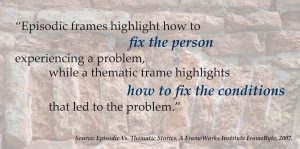Rethinking Personal Stories
October 27, 2016The National Reframing Initiative seeks to build Americans’ understanding of the human service sector and build public will for policy and systems solutions to the challenges it addresses. The FrameWorks Institute’s communications research shows us that using the Building Well-Being Narrative is quite effective in building a more expansive, more accurate view of the human service sector. It’s fair to say that this narrative isn’t the type of story we’re most familiar with, from entertainment, the news, or fiction. But, FrameWorks advises, it’s the type of story that our field has to get better at telling.
FrameWorks’ approach to narrative draws on the groundbreaking research of Shanto Iyengar, a political scientist at Stanford University. Professor Iyengar distinguishes between “episodic” and “thematic” stories. Episodic stories focus on a single event, or episode. Thematic stories, on the other hand:
“…apply a wide-angle lens to the coverage of the issue – focusing on trends over time, and highlighting contexts and environments.”
Source: Episodic Vs. Thematic Stories, A FrameWorks Institute FrameByte, 2007
Like most in the nonprofit sector, human services relies heavily on episodic stories in its communications. It doesn’t take long for a visitor to any of our websites to find one. These stories highlight individuals whose participation in a program helps them overcome significant personal challenges. They might feature an individual struggling to get by, or an individual who has tremendous success despite significant challenges or barriers.
We use these stories for a variety of reasons, assuming that they engage the public, make the issue at hand easier to understand, and help us to demonstrate the efficacy of our programs and services. And they might do some of these things – but FrameWorks points to social science research that suggests they have hidden, undesirable effects as well. Focusing on individual successes or challenges actually undercuts our efforts to engage the public in broader systemic solutions.

Telling episodic personal stories walks us right into one of the human service sector’s key communication challenges, the “Individualism Trap.” As uncovered by FrameWorks in the first phase of the National Reframing Initiative, the public has a narrow view of the sector as primarily providing temporary, direct service to individuals who are in crisis. When asked why people need these services, the public points to individual failings, such as a lack of drive or will power. Personal stories, even success stories, trigger common public misconceptions about our sector by:
- Emphasizing the role that individual actions play in causing or solving problems, while obscuring the role of systems and institutions;
- Leaving out large segments of the sector’s work, such as prevention, research, and advocacy; and
- Focusing on direct service recipients as the sector’s sole beneficiaries, rather than illuminating the broader societal benefits of the sector’s work.
In an upcoming newsletter, we will provide more guidance on how to tell thematic stories. In the meantime, we point you towards two fabulous FrameWorks resources on the topic:
- Wide Angle Lens, a free, multimedia learning module that explores the difference between episodic and thematic storytelling.
- Checklist for Advocates, a quick reference tool to help you determine if your communications materials are telling an episodic story or a thematic story.

